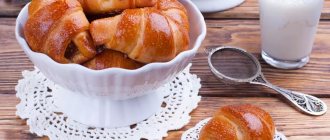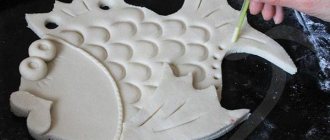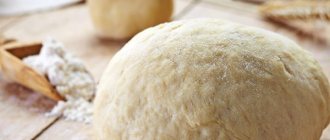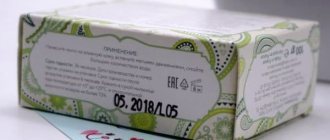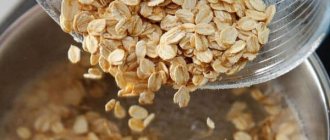Today we will return to the kitchen again and continue to solve problems directly related to it. But you have to solve enough problems and various tasks, and you don’t always immediately understand what needs to be done or, conversely, what you did wrong and why you got exactly the result you did. I think the situation with a pie is familiar to many: when the outside is about to turn black, you take it out of the oven (otherwise it’s just finished!), you think that the inside has already been ready for a long time, but for some reason the inside is not yet baked. Why, I wonder, does this happen, and how to prevent this from happening with the next pie?
If your pie is not baked. Why and what to do?
“What is this pie missing?” - you think, “what’s wrong, did I do it again?” Questions that you sometimes cannot answer for yourself. But really, what’s wrong?
- Quite often the reason for such an unbaked pie is the wrong temperature in the oven and the wrong time when you put the pie there. Many people start baking the cake immediately at a high temperature, 220 degrees. This is exactly what you don’t need to do. It is better to put it when the temperature there is lower, 160 degrees. And then, at this temperature, bake the pie for about 30 minutes. Of course, 30 minutes can also vary in any direction. Everything here will depend on the volume of your baking. After this time, you need to check inside for readiness. This is done with a match, a toothpick or a wooden skewer. I think many people do this procedure and know that the dough should not stick to these wooden objects if it is ready. Once you are sure that it is definitely ready inside, then you need to increase the temperature. This will allow you to brown your dish appetizingly.
- If you nevertheless made such a mistake this time, then it is also quite possible to save the pie, even though it is already too brown on the outside and a little damp on the inside. You just need to reduce the temperature in your oven, and it would be better to cover the pie itself with a suitable material that can withstand this temperature. This can be foil, or you can cover it with parchment paper instead.
- Sometimes the pie doesn’t bake because you didn’t add something, or you overloaded it, that is, you didn’t follow the recipe.
- Also, the pie can burn and remain damp inside due to the oven. That's just how she works. Therefore, you need to know the “character” and operating features of your oven or strive to quickly find out. So you don’t have to place the cake high right away, but place it at the very bottom of your oven to begin with. There the dough will rise better and it will be baked from below. After this, you can raise the cake higher, to where it should be during the baking process. Already on the top shelf of the oven it will be baked on top and will also be browned.
- In addition, when the inside of the pie is still damp, you can again turn down the heat a little, put some frying pan with water on a lower shelf, and then finish baking the pie, while greasing the top of it as well. You will have 10 or 15 minutes to finish baking the pie. and in humid air it will bake better.
- If your oven does not want to bake the cake from the inside, then it is better to buy a special one that has a hole in the middle. This way the middle will always bake without problems.
And finally, for you, a recipe for apple pie. Take a look, maybe decide to cook and please yourself and your loved ones at the same time.
Why do baked goods sag after baking? This question is always relevant for housewives. Those few who have all kinds of biscuit cupcakes remain safe and sound and delight with both taste and appearance, in the culinary world most people associate with magicians - since sometimes even the most “secret ingredients” and “tricks” do not help.
Despite everything, the situation is not as hopeless as it may seem. This is not the time to despair! And the question of why baked goods settle after baking also has its own answer. In this article we will look at why this can happen and how to avoid it.
Causes
Not all housewives are able to determine the cause of failure when baking bread or culinary products. Many factors can be to blame: failure to comply with the proportions of the required ingredients, the use of new household appliances, and violation of cooking time or temperature conditions. Let's look at some of them.
Types of test
The large variety of dough allows you to prepare hundreds of options for various baked goods. It is important to remember that they all require maintaining a certain temperature and knowledge of the nuances of preparation. For example:
Life hack: to check the readiness of the pie, you need to stick a match or a toothpick into it. If it is ready, the wooden surface will remain dry and nothing will stick to it.
New household appliances
Paradoxical as it may seem, new, even the most modern technology can cause a fiasco. Bakery specialists “It’s in the Dough” and experienced housewives know that you need to adapt to new kitchen appliances and understand their “character” and features. For example, one oven heats better in the lower part, while another heats better in the upper part. Therefore, it is possible that during the baking process you will have to move the baking sheet from the lower level to the upper and back several times.
Baking time
Culinary recipes from professionals and amateurs are created taking into account the characteristics of kitchen appliances, the material and diameter of the molds used by the creators of these recipes. Actual conditions may vary, so the cooking time will also be different. You should check the readiness yourself and adjust the cooking time accordingly.
Will diligence and labor grind everything down?
Reason number four: whipping too long with a mixer. Housewives who do not have this important attribute in the kitchen envy those who own it with not white envy. After all, you have to beat it manually: with a whisk, or even with a fork. But perhaps they were luckier in some ways? After all, a mixer can also be the reason why a sponge cake settles after baking? Or not a sponge cake, but a birthday cake, which everyone was so hoping for, and for which it is so offensive. The secret is that everything needs to be done in moderation: beat enough so that the dough is airy, but not so long that it “falls” from shock.
The right approach to different types of dough
There are many types of dough for pies: biscuit, yeast, shortbread, puff pastry, protein and more. Each of them has its own characteristics and requires an individual approach.
To prepare shortbread, all components must be chilled, and the temperature set in the oven must vary from 220 to 240 degrees. In order for the biscuit to bake evenly, you must strictly observe all the nuances of preparation, since despite the minimum set of ingredients, it is very capricious. The whites and yolks are beaten separately with the gradual addition of sugar and then flour. The finished pie is placed in an oven preheated to 200 degrees, but after 10-15 minutes the temperature must be reduced to 170 degrees. It is strictly forbidden to open the door, otherwise the cake will settle and will not bake well.
Puff pastry is high in fat. A large number of delicate crispy plates are obtained during baking if the cakes are baked at a high temperature - from 240 to 260 degrees. The oil will boil intensely, causing numerous layers to rise and bake, making the baked goods fluffy. In a low-heat oven, the layers simply will not rise, remaining stuck together, poorly baked and heavy.
Problems with yeast dough, which is also quite capricious, can arise if you take stale yeast, add too much of it, do not knead it well enough, and do not allow the cake to sit in a warm place before rising. If you immediately put it in the oven, a dense crust will form on the surface, and the inside of the baked goods will remain half-baked.
In order to bake the protein dough from which tender meringues are made, you need to beat the whites very well until they form stiff peaks, and place the cakes in a warm, not hot, oven (no more than 100 degrees). Otherwise, you won’t end up with tall, airy cake layers or pastries, but rather viscous, spreadable cakes.
Source
Mathematical proportionality - time to brainstorm
Reason number five: the proportions of the test components were violated. If too much flour or, on the contrary, liquid was initially added to the dough, it will not rise as the hostess wants. Beginners are advised to make the mixture exclusively according to the recipe, while more advanced ones should act almost intuitively, on a whim, selecting the amount of certain elements of the composition. In any case, this reason is a very clear example of how baked goods can be spoiled long before they are put into the oven.
How to revive the dough
If the problem of rising dough is identified before the cake is shaped and placed in the oven, the defect can be corrected. This primarily applies to yeast dough.
Increase ambient temperature
If the dough doesn't rise because the yeast doesn't have enough heat, you can:
If the dough has not risen within an hour, the problem is not the temperature.
Add yeast
If the amount of yeast in the recipe is incorrect or it is not active enough, you need to:
Finish kneading the dough
If the dough is sticky to the touch, but the recipe does not provide for this, then you should:
Dough made with pressed yeast “rises” longer than with dry yeast. Therefore, you should adjust the proofing time when replacing one with another.
What to do?
It is worth saying that sometimes preventing the mistakes described above does not help. And women clutch their heads, not knowing how to impress guests, family and friends with their cooking. Fortunately, all the secrets are freely available and are presented just below:
- Don't forget to sift the flour before adding it to the dough. It's a simple thing, but very useful. Airiness is guaranteed;
- optimality - in everything! Including the temperature of the water for breeding yeast in it. It should be exactly like that of a person bursting with health - thirty-six. Too cold a liquid will make you wait a long time until the dough deigns to “rise”, and a hot one will not only ruin the whole miracle of “rising”, but can even lead to spoilage of the product;
- Dishes - dry only! This is especially true for the one in which the whites will be beaten. One more note about this painstaking process: it is important to accurately separate the yolks from the whites. There are several ways to do this, including separating by hand, using a paper funnel, or using a knife or needles;
- intuition is intuition, and clear instructions are drawn up for a reason. If the recipe specifies an exact baking time, time it! Fortunately, stopwatches are not uncommon now. Otherwise, don’t ask why the cake sag after baking, but “enjoy” what has fallen. By the way, this also applies to temperature regulation: sometimes it is necessary during the baking process. Well, setting the required value at the beginning of cooking is a sacred task for servants of the culinary art;
- follow the sequence of actions. Remember how in Harry Potter? In order for the potion to turn out correctly, it is necessary not only to add all the ingredients, but in the correct order, and also to stir the exact number of times in a strictly indicated direction. Likewise, baking has its own secrets. For example, that soda cannot be extinguished separately from the dough, and especially not in advance. This is done directly together with the other ingredients, and is explained by the fact that the fluffiness should be achieved through gases, and if the product is not quenched in the dough, some of them (most of them) will simply evaporate.
Left damp inside
Temperature conditions also greatly affect the quality of the baked product.
At high temperatures, a situation is possible when the top is already covered with a fried crust, but the inside remains raw. In this case, you urgently need to reduce the temperature and continue baking until the manna is completely baked.
But it happens that they realized it too late and there is a danger of the cake burning on top.
You need to put a sheet of paper on it and again set the temperature lower. This can help a lot and save the situation.
Patience
Firstly, you should remember this rule once and for all: do not remove the baked goods immediately! Yes, this reason has already been indicated, but even experienced housewives “get caught” so often that it’s not a sin to remind you again. Temperature changes are a serious matter. When asked why the charlotte settles after baking, a cupcake or the same casserole - most likely, this was the problem. Sometimes it’s not even a matter of the baked goods being taken out—the dough most likely fell out the moment the oven door was opened. So you can’t even peek or even “look”!
Left damp inside
Temperature conditions also greatly affect the quality of the baked product.
At high temperatures, a situation is possible when the top is already covered with a fried crust, but the inside remains raw. In this case, you urgently need to reduce the temperature and continue baking until the manna is completely baked.
But it happens that they realized it too late and there is a danger of the cake burning on top.
You need to put a sheet of paper on it and again set the temperature lower. This can help a lot and save the situation.
Compound
If the cottage cheese casserole falls every now and then and there is no sweetness with it, you can experiment with the composition. There are many means to add fluffiness to culinary products: from soda slaked with vinegar/citric acid, etc., which was used by our grandmothers and great-grandmothers, to baking powder, helpfully supplied to the market by many manufacturers and sold at every kiosk. Essentially, of course, it will most likely contain the same soda and the same citric acid. But if the housewife is accustomed to trusting purchased products, why not? After all, they also work. In addition, there is definitely less hassle with them. There is no need to think about at what point to add and how to “extinguish” the baking powder. He will do everything himself.
Both baking soda and baking powder are an option for the most persistent, but it is very important to remember that it is important not to overdo it with these products. After all, in the end, the baked goods will not only fall, but will not rise, and will also smell of soda and ammonia (this is sometimes found in baking powder).
Do you have new household appliances in your home?
A common cause is a new stove or other baking-capable appliance. You haven’t gotten used to it yet and don’t know her “character.” Oddly enough, you will have to get used to the device; sometimes they cook differently and you need to know their whims.
To do this, experiment. Place the pie at the very bottom first and see what happens, then up. On the lower level, the dish is baked better on the outside, and it cooks better on the upper level. You may have to rearrange it several times during one cooking.
And again, it all depends on the capabilities of the technology. For the first time, you can buy a special mold with a hole in the middle. It will help bring the dish to the desired condition.
Cold and hot
There are two ways to prepare a sponge cake. More precisely, the dough is for him. Depending on which one the hostess chooses, she will receive one or another result.
It cannot be said that one is guaranteed to be better and the other worse. But cold is suitable for ethereal-light rolls, the crumbliness of which is unbecoming.
A hot one gives a dense result, and after it you don’t have to wonder why the sponge cake settles after baking - after all, this usually doesn’t happen.
With this method, the dough is prepared in a water bath. It should be noted that many cooks prefer the cold method - as it is lighter, simpler and more understandable. But if the main thing is the result, it would be good not to be lazy and work hard to get the perfect sponge cake that will not fall.
The subtleties of baking a pie in a slow cooker
- Check if the recipe is suitable for this model. The power and functions of different multicookers are not the same, so the cooking time indicated for one model will not work on another.
- In some cases, the “Multi-cook” mode will help, in which you manually set the time - 15-20 minutes.
- It will take more time to cook in a slow cooker: 50-60 minutes are recommended for baking. However, you cannot open it earlier.
- The “Keep Warm” mode allows the cake to finish baking in the multicooker.
Do not put more into the slow cooker than it can bake. A simple way to determine the quantity: the height of the pie when raw should not be more than 3 fingers.
Baked goods burn
If your baked goods are constantly burning on top in your gas oven, try placing a fire brick in the bottom of the oven and preheating the oven with it for 30 minutes longer than usual. Otherwise, simply move the rack down one notch and cover the pie with foil. If the pies turn out darker on one side than the other, turn the pan 180 degrees when half the time has passed. If it burns at the bottom, move it one notch higher accordingly.
Answers:
If the cake is not baked inside, but its top is already well browned, you should urgently reduce the oven temperature and cover the product with parchment paper or foil. The cake is not baked inside if the correct recipe is not followed. The individual characteristics of different ovens also have an effect, and this can only be understood by studying the “character” of your own oven. For example, you can first place the baking sheet with the pie at the very bottom of the oven so that the dough rises better and bakes from below. Then raise the baking sheet to the very top of the oven so that the pie is baked and browned on top.

